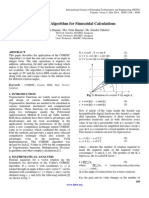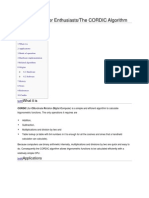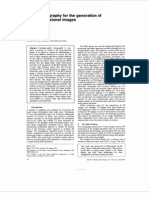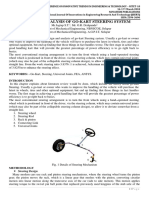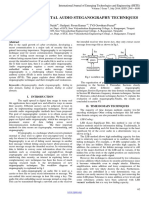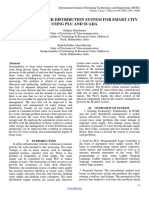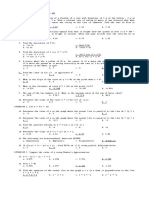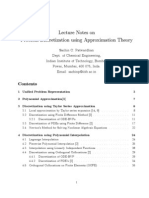Computing The Satellite's Coordinates Using CORDIC Algorithm
Computing The Satellite's Coordinates Using CORDIC Algorithm
Uploaded by
ijeteeditorCopyright:
Available Formats
Computing The Satellite's Coordinates Using CORDIC Algorithm
Computing The Satellite's Coordinates Using CORDIC Algorithm
Uploaded by
ijeteeditorOriginal Title
Copyright
Available Formats
Share this document
Did you find this document useful?
Is this content inappropriate?
Copyright:
Available Formats
Computing The Satellite's Coordinates Using CORDIC Algorithm
Computing The Satellite's Coordinates Using CORDIC Algorithm
Uploaded by
ijeteeditorCopyright:
Available Formats
International Journal of Emerging Technologies and Engineering (IJETE) ISSN: 23488050
ICRTIET-2014 Conference Proceeding, 30th -31st August 2014
Computing the Satellites Coordinates using CORDIC Algorithm
Ms. Ankita Sharma * Mrs. Neha Sharma** Mrs. Sukomal
**M. Tech. Scholar, S.G.T. Institute of Engineering & technology, Gurgaon
** Asst. Professor, SGTIET, Gurgaon
*** Asst. Professor, SGTIET, Gurgaon
Abstract
This paper describes the application of the CORDIC
Algorithms to find the coordinates of the satellite in the
x-y plane. The mathematical and analytical approach for
the CORDIC algorithm implementation is presented here
which shows that CORDIC algorithm revolves around
the idea of "rotating" the phase of a complex number, by
multiplying it by a succession of constant values.
Keywords: algorithm, azimuth, coordinates, CORDIC,
Elevation, Look angles.
2. MATHEMATICAL ANALYSIS
General equations for a vector rotation lays the
foundation for derivation of the Volder's CORDIC
algorithm. If a vector V with coordinates (x, y) is rotated
through an angle then a new vector V ' can be obtained
with coordinates (x', y') where x' and y' can be obtained
using x, y and by the following method.
X = r cos , Y = r sin
(1)
(x) = (x. cos () y.sin ())
(2)
(y) = (y.cos () +x.sin ())
(3)
1. INTRODUCTION
The coordinates to which an earth station
antenna must be pointed to communicate with the
satellite are called the Look Angles. These are most
commonly expressed as azimuth (Az) and elevation (El).
Azimuth is measured eastwards from the geographic
north to the projection of the satellite path on a locally
horizontal plane at the earth station. Elevation angle is
measured upward from the local horizontal plane at the
earth station to the satellite path.
Fig. 2: Rotation of a vector V by angle
Fig. 1: Look Angles for a Satellite
The name CORDIC is an acronym for Coordinate
Rotation Digital Computer. In 1959 Jack E. Volder
described the Coordinate Rotation Digital Computer or
CORDIC for the calculation of trigonometric functions,
multiplication, division and conversion between binary
and mixed radix number systems. The CORDICalgorithm provides an iterative method of performing
vector rotations by arbitrary angles using only shift and
add.
x = cos()[x - y.tan()]
(4)
y = cos()[y + x.tan()]
(5)
The multiplication by the tangent term can be avoided if
the rotation angles and therefore tan() are restricted so
that tan() =2-i .In digital hardware this denotes a simple
shift operation. Furthermore, if those rotations are
performed iteratively and in both directions every value
of tan () is presentable with = arctan(2-i ) the cosine
term could also be simplified and since cos() = cos(-)
it is a constant for a fixed number of iterations. This
iterative rotation can now be expressed as:
xi+1 = ki [xi yi.di.2-i]
(6)
yi+1 = ki [yi xi.di.2-i]
(7)
where, i denotes the number of rotation required to reach
the required angle of the required vector, cos(arctan(2-i ))
and di = 1. The product of the Kis represents the socalled K factor :
Divya Jyoti College of Engineering & Technology, Modinagar, Ghaziabad (U.P.), India
38
International Journal of Emerging Technologies and Engineering (IJETE) ISSN: 23488050
ICRTIET-2014 Conference Proceeding, 30th -31st August 2014
1
=0
k=
(8)
1
Where
=0 = cos0 cos1 cos2 cos3 cos4
.................cosn-1( is the angle of rotation here for n
times rotation).
Table 1: Values of Angles for 8-bit CORDIC H/W
d-i =
2 =tani
1
i=
arctan(2-i)
45o
in radian
0.7854
0.5
0.4636
0.25
26.565o
14.036o
0.125
0.1244
0.0625
7.125o
3.576o
0.03125
0.0312
0.015625
1.7876o
0.8938o
0.0078125
0.4469o
0.0078
-i
0.2450
0.0624
0.0156
Ki is the gain and its value changes as the number of
iteration increases. For 8-bit hardware CORDIC
approximation method the value of ki as
ki = 7=0 cos = cos0 . cos1 . cos2. cos3 . cos4 .
cos5 . cos6 . cos7
=cos45.cos26.565.. cos0.04469 = 0.6073
(9)
From the above table it can be seen that precision up to
0.4469 is possible for 8-bit CORDIC hardware.
To simplify each rotation, picking i (angle of rotation in
ith iteration) such that i = di . 2-i . di is such that it has
value +1 or -1 depending upon the rotation i. e. di {+1,1} . Then
xi+1 = xi - di yi 2i
(9)
yi+1 = yi - di xi 2-I
(10)
zi+1 = zi - di tan-12-I
(11)
The computation of xi+1 or yi+1 requires an i-bit right
shift and an add/subtract. If the function tan-12-i is pre
computed and stored in table (Table 3.1) for different
values of i, a single add/subtract suffices to compute zi+1.
Each CORDIC iteration thus involves two shifts, a table
lookup and three additions. If the rotation is done by the
same set of angles (with + or - signs), then the expansion
factor K, is a constant, and can be pre computed. For
example to rotate by 30 degrees, the following sequence
of angles be followed that add up to 30 degree.
30.0 45.0 - 26.6 + 14.0 - 7.1 + 3.6 + 1.8 - 0.9 + 0.4 0.2 + 0.1
= 30.1
In effect, what actually happens in CORDIC is that z is
initialized to 30 degree and then, in each step, the sign of
the next rotation angle is selected to try to change the
sign of z; that is, di = sign ( zi ) is chosen, where the sign
function is defined to be -1 or +1 depending on whether
the argument is negative or non-negative. This is
reminiscent of no restoring division. Table 2 shows the
process of selecting the signs of the rotation angles for a
desired rotation of +30 degree.
Table 2: Choosing
force z to zero
I
0
1
2
3
4
5
6
7
8
9
the signs of the rotation angles to
zi - i
+30.0 - 45.0
- 15.0 + 26.6
+ 11.6 - 14.0
- 2.4 + 7.1
+ 4.7 - 3.6
+ 1.1 - 1.8
- 0.7 + 0.9
+ 0.2 - 0.4
- 0.2 + 0.2
+ 0.0 - 0.1
zi+1
-15
11.6
-2.4
4.7
1.1
-0.7
0.2
-0.2
0
-0.1
Figure 3: First three of 10 iteration leading from (x0, y0)
to (x 1, y1) in rotating by +30, rotation mode.
3. ALGORITHMIC APPROACH
CORDIC can be used to calculate a number of
different functions. This explanation shows how to use
CORDIC in rotation mode to calculate sine and cosine
of an angle, and assumes the desired angle is given in
radians and represented in a fixed point format. To
determine the sine or cosine for an angle , the y or x
coordinate of a point on the unit circle corresponding to
the desired angle must be found. Using CORDIC, we
would start with the vector vo:
vo= [1,0]
(12)
Divya Jyoti College of Engineering & Technology, Modinagar, Ghaziabad (U.P.), India
39
International Journal of Emerging Technologies and Engineering (IJETE) ISSN: 23488050
ICRTIET-2014 Conference Proceeding, 30th -31st August 2014
In the first iteration, this vector would be rotated 45
counterclockwise to get the vector v1. Successive
iterations will rotate the vector in one or the other
direction by size decreasing steps, until the desired angle
has been achieved. Step i size is arctan (1/(2i1)) for
i = 1, 2, 3, .
Fig 4: Flowchart for CORDIC Algorithm
4. CONCLUSION
This paper presents mathematical and analytical
aspects of implementing the CORDIC algorithm for
satellites communication. For sinusoidal angle
calculations in look angle computations this method can
provide n-bit accuracy for n iterations. This method is
much simpler than the conventional methods as the
computations are reduced to only shift and add
operations instead of the complex multiplication
operations. On the other hand, when a hardware
multiplier is available (e.g. in a DSP microprocessor),
table-lookup methods and power series are generally
faster than CORDIC.
REFERENCES
[1] Ayansola, O.D, Mathematical modelling of antenna
look angles of geostationary communications satellite
using two models of control stations IEEE Conference
Publications- 3rd International Conference on Advanced
Computer Theory and Engineering (ICACTE), 2010
[2] Ogundele, D.A. Model validation and analysis of
antenna look angles of geostationary satellite. IEEE
Conference Publications . International Conference on
Computer Science and Automation Engineering
(CSAE), 2012
[3] R.Andraka. A Survey of CORDIC Algorithms for
FPGA Based Computersn Proc. Of the 1998
CM/SIGDA Sixth International Symposium on FPGAs,
February1998, Monterey, CA, pp.191-200.
[4] P.W.Baker. Suggestion for a Binary Cosine
Generator, IEEE Transactions on Computers, February,
1975, pp. 1134-1136.
[5] M.Marx. FPGA Implementation of sin(x) and cos(x)
Generators Using the CORDIC Algorithm, Final Year
Project Report, School of Electronic Engineering,
University of Surrey, Guidford, UK, 1999. s
[6] P.Pirsch. Architectures for Digital Signal Processing,
John Wiley & Sons,1998.
[7] N.Takagi. Redundant CORDIC Methods with a
Constant Scale Factor for Sine and Cosine Computation,
IEEE Trans. On Comput., vol. 40, n 9, 1991, pp. 989994.
[8] D.Timmerman, H.Hahn, B.J.Hosticka, B.Rix. A New
Addition Scheme and Fast Scaling Factor Compensation
Methods for CORDIC algorithms, Integration the
VLSI Journal, vol. 11, n 1, 1991, pp. 85-100.
[9] A.Vlachos. Design and Implementation of CORDIC
Modules for ADCS, MSc Project Report, School of
Electronic Engineering, University of Surrey, Guidford,
UK, 1999.
[10] J.Volder. The CORDIC Computing Technique, IRE
Trans. Comput., Sept.1959, pp.330-334.
[11] J.S. Walther. A Unified Algorithm for Elementary
Functions, Proc. AFIPS Spring Joint Computer
Conference, pp.379-385, 1971.
Divya Jyoti College of Engineering & Technology, Modinagar, Ghaziabad (U.P.), India
40
You might also like
- Keith Johnson, Simmone Hewett, Sue Holt, John Miller - Advanced Physics For You, 2nd Edition-Oxford University Press (2015) (Z-Lib - Io)Document515 pagesKeith Johnson, Simmone Hewett, Sue Holt, John Miller - Advanced Physics For You, 2nd Edition-Oxford University Press (2015) (Z-Lib - Io)kalbna93No ratings yet
- CORDIC Algorithm For Sinusoidal CalculationsDocument6 pagesCORDIC Algorithm For Sinusoidal CalculationsijeteeditorNo ratings yet
- Analysis of Simple CORDIC Algorithm Using MATLABDocument3 pagesAnalysis of Simple CORDIC Algorithm Using MATLABamit.18.singh2466No ratings yet
- Precision Robotic Displacement Using FPGA: Aswathy Surendran.P, V.Saminathan, M.UdhayakumarDocument4 pagesPrecision Robotic Displacement Using FPGA: Aswathy Surendran.P, V.Saminathan, M.UdhayakumarerpublicationNo ratings yet
- Simulink Design of Pipelined CORDIC For Generation of Sine and Cosine ValuesDocument5 pagesSimulink Design of Pipelined CORDIC For Generation of Sine and Cosine ValuesInternational Journal of computational Engineering research (IJCER)No ratings yet
- Cordic SVD HWDocument6 pagesCordic SVD HWasdf2828No ratings yet
- Scaling Free CORDIC Algorithm Implementation of Sine and Cosine FunctionDocument4 pagesScaling Free CORDIC Algorithm Implementation of Sine and Cosine FunctionharivarahiNo ratings yet
- FPGA Implementation of Sine and Cosine Generators Using The CORDIC AlgorithmDocument13 pagesFPGA Implementation of Sine and Cosine Generators Using The CORDIC AlgorithmGovind AtalNo ratings yet
- Trigonometry/For Enthusiasts/The CORDIC Algorithm: What It IsDocument9 pagesTrigonometry/For Enthusiasts/The CORDIC Algorithm: What It Isamit.18.singh2466No ratings yet
- Coordinate Rotation-Based Design Methodology For Square Root and Division ComputationDocument5 pagesCoordinate Rotation-Based Design Methodology For Square Root and Division Computationpradipta.sarkarNo ratings yet
- GEO108E 2324B TermProject-InstructionsDocument10 pagesGEO108E 2324B TermProject-Instructionserbasayse073No ratings yet
- FPGA Implementation of Sine and Cosine Generators Using The CORDIC AlgorithmDocument9 pagesFPGA Implementation of Sine and Cosine Generators Using The CORDIC AlgorithmANIL KUMAR MANNAMNo ratings yet
- A Survey of CORDIC Algorithms For FPGA Based Computers: Ray AndrakaDocument0 pagesA Survey of CORDIC Algorithms For FPGA Based Computers: Ray AndrakaCix XidNo ratings yet
- Radix 8Document7 pagesRadix 8Loc LeNo ratings yet
- CORDIC - Wikipedia, The Free EncyclopediaDocument7 pagesCORDIC - Wikipedia, The Free EncyclopediaJonjon JoneeNo ratings yet
- A.S.N Mokhtar - Implementation of Trigonometric FunctionDocument8 pagesA.S.N Mokhtar - Implementation of Trigonometric FunctionMohamed GanounNo ratings yet
- Chinna Thambi 2014Document5 pagesChinna Thambi 2014DlishaNo ratings yet
- Bit Serial Iterative Cordic Implementation For The Calculation of Trigonometric FunctionsDocument8 pagesBit Serial Iterative Cordic Implementation For The Calculation of Trigonometric Functionsaakanksha080No ratings yet
- CORDICDocument8 pagesCORDICRofaelEmilNo ratings yet
- Hardware Implementation of Cordic Algorithm - 240506 - 225944Document3 pagesHardware Implementation of Cordic Algorithm - 240506 - 225944ninja0072004No ratings yet
- Radar Tomography For The Generation of Three-Dimensional ImagesDocument7 pagesRadar Tomography For The Generation of Three-Dimensional ImagesMuhammad RosliNo ratings yet
- Civil 3D, The ModernDocument60 pagesCivil 3D, The ModernCarlos Macedo CarvalhoNo ratings yet
- Experiment Report Format.docxDocument6 pagesExperiment Report Format.docxrahulnaireceNo ratings yet
- An Efficient VLSI Architecture For CORDIC AlgorithmDocument12 pagesAn Efficient VLSI Architecture For CORDIC AlgorithmAnonymous hh95x9VkPNo ratings yet
- Design of A New Metamaterial Structure To Enhancement TheDocument6 pagesDesign of A New Metamaterial Structure To Enhancement TheIAEME Publication100% (1)
- Catia Aided Radome Analysis Using Geometric Optics MethodDocument5 pagesCatia Aided Radome Analysis Using Geometric Optics MethodAbrham Yair Aguilar RodriguezNo ratings yet
- Tutorial 3: Autumn-2022Document3 pagesTutorial 3: Autumn-2022Raman kumarNo ratings yet
- Pipelined CORDIC Design On FPGA For A Digital Sine and Cosine Waves GeneratorDocument4 pagesPipelined CORDIC Design On FPGA For A Digital Sine and Cosine Waves GeneratorMohamed GanounNo ratings yet
- P S ECE 645: C: .: Roject Pecification Omputer Arithemetic Implementaiton in Hardware and SoftwareDocument6 pagesP S ECE 645: C: .: Roject Pecification Omputer Arithemetic Implementaiton in Hardware and SoftwareHarsh BaghelNo ratings yet
- Computer Graphics Final-1Document32 pagesComputer Graphics Final-1Semakula CalvinNo ratings yet
- Icee2022 BousbiaDocument8 pagesIcee2022 BousbiaDjedili AmelNo ratings yet
- Machining of Bezier Curve by Macro ProgrammingDocument7 pagesMachining of Bezier Curve by Macro ProgrammingAtul ChauhanNo ratings yet
- Engineering Survey 2Document24 pagesEngineering Survey 2liban abdi elmiNo ratings yet
- Pipelined Cordic Architecture and Its Implementation On SimulinkDocument10 pagesPipelined Cordic Architecture and Its Implementation On SimulinkMohamed GanounNo ratings yet
- daa PBLDocument15 pagesdaa PBLamanNo ratings yet
- Cordic: (Coordinate Rotation Digital Computer)Document25 pagesCordic: (Coordinate Rotation Digital Computer)santhiyadevNo ratings yet
- Cordic: (Coordinate Rotation Digital Computer)Document25 pagesCordic: (Coordinate Rotation Digital Computer)Magdalene MilanNo ratings yet
- Angular Glint Modeling and Simulation For Complex Targets: Junji Chen, Fang Yang, Kai Zhang and Jiadong XuDocument3 pagesAngular Glint Modeling and Simulation For Complex Targets: Junji Chen, Fang Yang, Kai Zhang and Jiadong XuAlex YangNo ratings yet
- CORDIC Designs For Fixed Angle of Rotation: Pramod Kumar Meher, Senior Member, IEEE, and Sang Yoon Park, Member, IEEEDocument12 pagesCORDIC Designs For Fixed Angle of Rotation: Pramod Kumar Meher, Senior Member, IEEE, and Sang Yoon Park, Member, IEEEak86No ratings yet
- AFully Mechanical Realizationof PIDControllerDocument10 pagesAFully Mechanical Realizationof PIDControllermarcelo.vicentiniNo ratings yet
- Review Article: CORDIC Architectures: A SurveyDocument20 pagesReview Article: CORDIC Architectures: A SurveyDarshan KumarNo ratings yet
- l4 Control Survey TraverseDocument23 pagesl4 Control Survey TraverseSerinaaNo ratings yet
- Assignment Report On Cordic Algorithm Implementation Using VerilogDocument27 pagesAssignment Report On Cordic Algorithm Implementation Using VerilogAyanabho BanerjeeNo ratings yet
- Implementation of Cordic Algorithm Using Matlab & VHDL For Wlan ReceiverDocument3 pagesImplementation of Cordic Algorithm Using Matlab & VHDL For Wlan ReceiverHemant SaraswatNo ratings yet
- Research Article Special Issue: Anis@upnm - Edu.myDocument15 pagesResearch Article Special Issue: Anis@upnm - Edu.myMohamed GanounNo ratings yet
- A Novel Approach For The Design and Implementation of FPGA Based High Speed Digital Modulators Using Cordic AlgorithmDocument6 pagesA Novel Approach For The Design and Implementation of FPGA Based High Speed Digital Modulators Using Cordic AlgorithmRijo SebastianNo ratings yet
- As QBDocument5 pagesAs QBveerublogger100% (1)
- Surveying TutorialDocument3 pagesSurveying Tutoriallangazelamoyo19No ratings yet
- GPU Accelerated Hough Transformation For HLT Application: CERN, CH-1211, Geneve 23, SwitzerlandDocument24 pagesGPU Accelerated Hough Transformation For HLT Application: CERN, CH-1211, Geneve 23, SwitzerlandsidNo ratings yet
- 200 - FEM Based Structural Analysis of Quadcopter UAV Chassis Produced With 3D Printer - 2020Document9 pages200 - FEM Based Structural Analysis of Quadcopter UAV Chassis Produced With 3D Printer - 2020OKA FATRANo ratings yet
- A Geometric Approach to Inverse Kinematics of a 3 Dof 49ctxbp3lrDocument9 pagesA Geometric Approach to Inverse Kinematics of a 3 Dof 49ctxbp3lrSK WritersNo ratings yet
- CORDIC For QAM and AM Signal Generation: 2013 International Conference On Advanced Electronic Systems (ICAES)Document5 pagesCORDIC For QAM and AM Signal Generation: 2013 International Conference On Advanced Electronic Systems (ICAES)rupeshNo ratings yet
- Stadia TacheometryDocument13 pagesStadia Tacheometryadolfomc200150% (2)
- Mathematical Modeling of Electrical Machines Using Circle Diagram R S ShekhawatDocument10 pagesMathematical Modeling of Electrical Machines Using Circle Diagram R S ShekhawatPrakash SoniNo ratings yet
- CAD-01-UncutFreePocketing PDFDocument8 pagesCAD-01-UncutFreePocketing PDFetet100No ratings yet
- Design and Analysis of Go-Kart Steering SystemDocument5 pagesDesign and Analysis of Go-Kart Steering SystemIJIERT-International Journal of Innovations in Engineering Research and TechnologyNo ratings yet
- 10.1007@s00006 016 0698 2Document16 pages10.1007@s00006 016 0698 2Uli Urio-LegoNo ratings yet
- Parallel Algorithm For Computing Edt With New ArchitectureDocument17 pagesParallel Algorithm For Computing Edt With New ArchitectureIAEME PublicationNo ratings yet
- A New Memory Reduced Radix-4 CORDIC Processor For FFT OperationDocument8 pagesA New Memory Reduced Radix-4 CORDIC Processor For FFT OperationFadhil SahibNo ratings yet
- Two Dimensional Computer Graphics: Exploring the Visual Realm: Two Dimensional Computer Graphics in Computer VisionFrom EverandTwo Dimensional Computer Graphics: Exploring the Visual Realm: Two Dimensional Computer Graphics in Computer VisionNo ratings yet
- Planar Linkage Synthesis: A modern CAD based approachFrom EverandPlanar Linkage Synthesis: A modern CAD based approachNo ratings yet
- Near-Net-Shape Superplastic Forming of Intricate Shaped Magnesium Alloy ComponentsDocument8 pagesNear-Net-Shape Superplastic Forming of Intricate Shaped Magnesium Alloy ComponentsijeteeditorNo ratings yet
- Modeling and Simulation of Single Phase CycloconvertorDocument3 pagesModeling and Simulation of Single Phase CycloconvertorijeteeditorNo ratings yet
- Buckling Analysis of Rectangular Plate by Split-Deflection MethodDocument4 pagesBuckling Analysis of Rectangular Plate by Split-Deflection MethodijeteeditorNo ratings yet
- Overview of Digital Audio Steganography TechniquesDocument5 pagesOverview of Digital Audio Steganography TechniquesijeteeditorNo ratings yet
- Electrical Vehicle Charging by Wireless Power Transfer Using High-Power Three Level DC-DC ConvertersDocument5 pagesElectrical Vehicle Charging by Wireless Power Transfer Using High-Power Three Level DC-DC ConvertersijeteeditorNo ratings yet
- Automated Water Distribution System For Smart City Using PLC and ScadaDocument4 pagesAutomated Water Distribution System For Smart City Using PLC and ScadaijeteeditorNo ratings yet
- Implimantation of Statistical Process Control in Small Scale Industries-A ReviewDocument4 pagesImplimantation of Statistical Process Control in Small Scale Industries-A ReviewijeteeditorNo ratings yet
- Current Mode Controller Design For Single Phase Grid Connected Inverter Using Proportional Resonant Control StrategyDocument6 pagesCurrent Mode Controller Design For Single Phase Grid Connected Inverter Using Proportional Resonant Control StrategyijeteeditorNo ratings yet
- An Efficient and Reliable Data Routing For In-Network Aggregation in Wireless Sensor NetworkDocument4 pagesAn Efficient and Reliable Data Routing For In-Network Aggregation in Wireless Sensor NetworkijeteeditorNo ratings yet
- Use of PET (POLY ETHYLENE TERAPHTALATE) WASTE in Bituminous Road Construction - A Critical ReviewDocument4 pagesUse of PET (POLY ETHYLENE TERAPHTALATE) WASTE in Bituminous Road Construction - A Critical ReviewijeteeditorNo ratings yet
- Experimental Study On Self Curing Concrete Using Sodium LignosulphonateDocument5 pagesExperimental Study On Self Curing Concrete Using Sodium LignosulphonateijeteeditorNo ratings yet
- An Experimental Work On Concrete by Adding Bacillus SubtilisDocument5 pagesAn Experimental Work On Concrete by Adding Bacillus SubtilisijeteeditorNo ratings yet
- Digital Watermarking Using Least Significant Bit AlgorithmDocument4 pagesDigital Watermarking Using Least Significant Bit AlgorithmijeteeditorNo ratings yet
- (Arbelos Volume 1 (1982-1983) ) Dr. Samuel Greitzer-American Mathematics Competitions (1982)Document104 pages(Arbelos Volume 1 (1982-1983) ) Dr. Samuel Greitzer-American Mathematics Competitions (1982)wikarosNo ratings yet
- Competitions For Students of Class IXDocument14 pagesCompetitions For Students of Class IXsudhir_kumar_33No ratings yet
- Circle Relationships: Central Angle Congruent Chords Inscribed AngleDocument15 pagesCircle Relationships: Central Angle Congruent Chords Inscribed Anglevgci bea nyxieNo ratings yet
- Digital Signal Processing Lab: Vishavjit Singh CSE-1 (6 Sem) 0581322707Document22 pagesDigital Signal Processing Lab: Vishavjit Singh CSE-1 (6 Sem) 0581322707rsdelhi123No ratings yet
- Mathematics 12vol2Document150 pagesMathematics 12vol2shashwatthool04No ratings yet
- Deleted Syllabus of Maths For The Academic Year 2020-21Document5 pagesDeleted Syllabus of Maths For The Academic Year 2020-21Swarnalatha SwarnalathaNo ratings yet
- Differential Calculus RefreshDocument3 pagesDifferential Calculus RefreshKevin Pontillas100% (2)
- Sample Math Analysis FinalDocument6 pagesSample Math Analysis FinalDr. Mike D. CookNo ratings yet
- DSP Lab Report11708039Document20 pagesDSP Lab Report11708039Kaysar AhmedNo ratings yet
- Labelling (AU) 25 Metres, A1 For Drawing (TU) .: IB Questionbank Maths SL 1Document9 pagesLabelling (AU) 25 Metres, A1 For Drawing (TU) .: IB Questionbank Maths SL 1Yarden KumarNo ratings yet
- Mathematics: Republic of Liberia Ministry of Education National Curriculum For Grades 10 To 12Document68 pagesMathematics: Republic of Liberia Ministry of Education National Curriculum For Grades 10 To 12Alexia L. SaizonouNo ratings yet
- Four Center Note (Dragged) Window PDFDocument20 pagesFour Center Note (Dragged) Window PDF918goodyNo ratings yet
- Using Logo To Model and Animate - Eurologo 2005 - Pavel BoytchevDocument10 pagesUsing Logo To Model and Animate - Eurologo 2005 - Pavel BoytchevHelder DuraoNo ratings yet
- 21 TrigonometryDocument13 pages21 TrigonometryAnonymous CqvX8eNo ratings yet
- Chapter 1 (Preliminaries)Document129 pagesChapter 1 (Preliminaries)Sajjad AhmadNo ratings yet
- Calculus WorkbookDocument114 pagesCalculus Workbookrandonam100% (1)
- Sma 200 Calculus IIDocument130 pagesSma 200 Calculus IIKen MangeiNo ratings yet
- ContinuousFunctions PDFDocument14 pagesContinuousFunctions PDFbenalyn ignacioNo ratings yet
- TCL TK Reference GuideDocument149 pagesTCL TK Reference GuideAnand ChaudharyNo ratings yet
- Fourier Series and IntegralsDocument10 pagesFourier Series and IntegralsFahrudin MNo ratings yet
- Stitz, Zeager - College Algebra, 3rd Corrected Ed (2011)Document757 pagesStitz, Zeager - College Algebra, 3rd Corrected Ed (2011)anshulsononeNo ratings yet
- Algebra Bilingual Glossary Chinese Simplified-EnglishDocument12 pagesAlgebra Bilingual Glossary Chinese Simplified-Englishaehsgo2collegeNo ratings yet
- PH103 Midsem IITBDocument7 pagesPH103 Midsem IITBAnkit SharmaNo ratings yet
- Interactive Unit Circle ActivityDocument10 pagesInteractive Unit Circle Activityapi-260038645No ratings yet
- L. 5.2 Day 1 Worksheet Answer KeyDocument3 pagesL. 5.2 Day 1 Worksheet Answer Keywaleedkhanfar76No ratings yet
- SSC Mts Maths Syllabus 8259b8abDocument3 pagesSSC Mts Maths Syllabus 8259b8abRavi SharmaNo ratings yet
- CC-112L Programming Fundamentals Laboratory 04 Modular Program Development - IDocument20 pagesCC-112L Programming Fundamentals Laboratory 04 Modular Program Development - IAiman SNo ratings yet
- Problem Discretization Approximation Theory RevisedDocument76 pagesProblem Discretization Approximation Theory RevisedNishanth Murthy KottapalliNo ratings yet
- NCERT Solutions for Class 11 Maths Chapter 3 Trigonometric Functions - Free PDF DownloadDocument56 pagesNCERT Solutions for Class 11 Maths Chapter 3 Trigonometric Functions - Free PDF DownloadMaikalNo ratings yet

